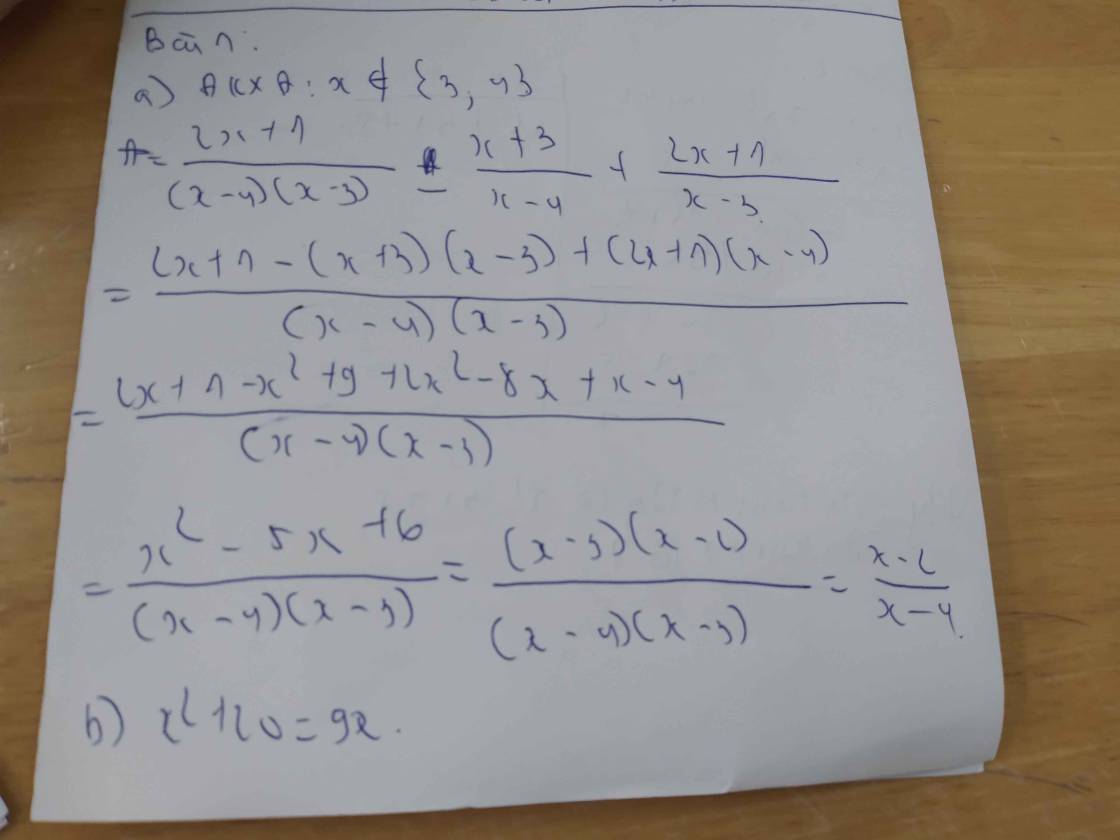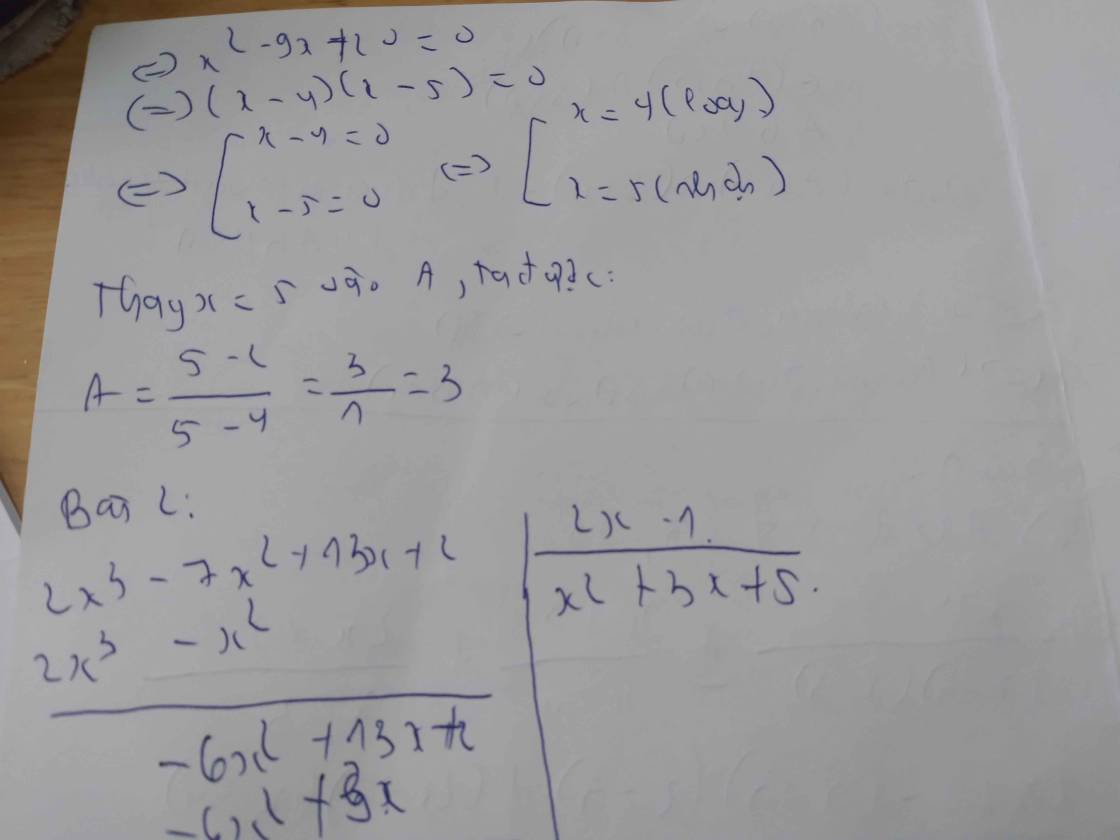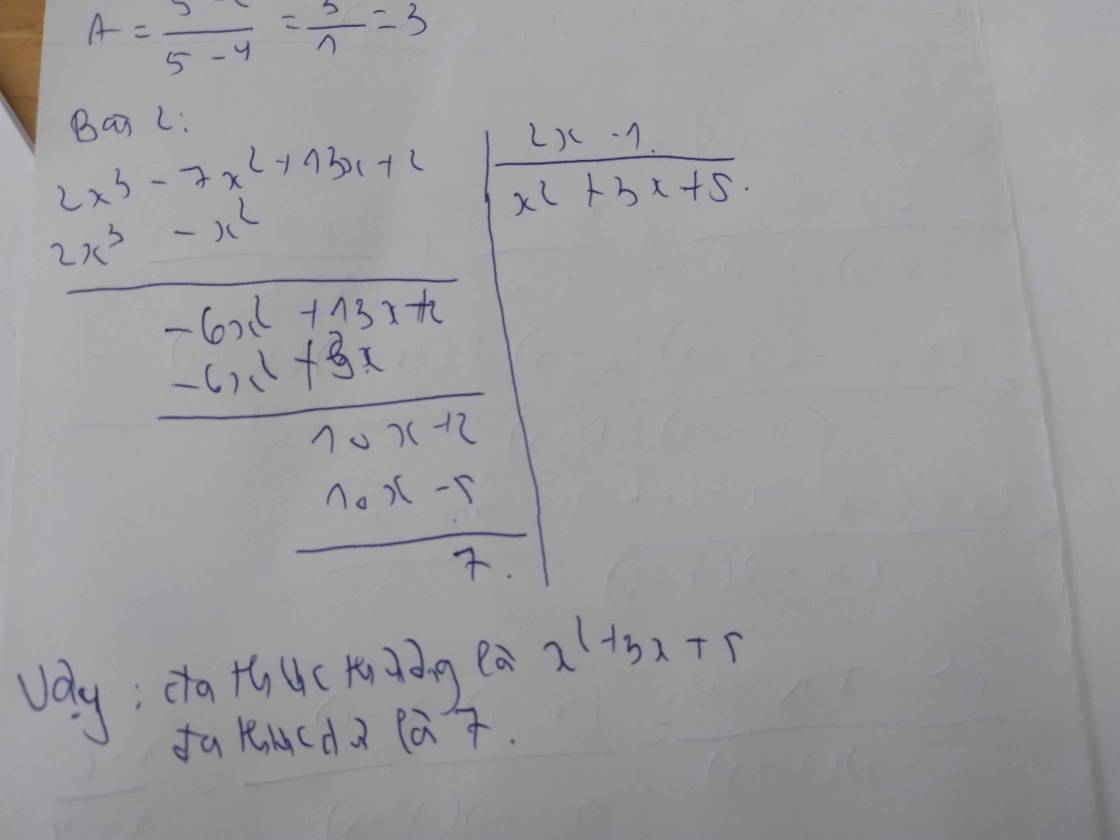1.Cho A=\(\dfrac{2x+1}{\left(x-4\right)\left(x-3\right)}-\dfrac{x+3}{x-4}+\dfrac{2x+1}{x-3}\)
a.Rút gọn biểu thức A
b.Tính giá trị của A biết \(x^2+20=9x\)
2.Tìm đa thức thương vfa đa thức dư trong phép chia:\(\left(2x^3-7x^2+13x+2\right):\left(2x-1\right)\)
3.Cho hình thang ABCD có góc A = góc D = 90 độ,AB=AD=\(\dfrac{1}{2}\)CD.Gọi M là trung điểm của CD.
a.Tứ giác ABCM;ABCD là hình gì?Vì sao?
b.Cho AC cắt BD tại E, AM cắt BD tại O.Gọi N là trung điểm của MC.C/m tứ giác DOEN là hình thang cân.
c.Kẻ DI vuông góc vs AC (I thuộc AC) DI cắt AM tại H.Gọi K là giao điểm của AM và DE.C/m DH=DK
(vẽ hình giúp e vs ạ, e cảm ơn)
Hãy nhập câu hỏi của bạn vào đây, nếu là tài khoản VIP, bạn sẽ được ưu tiên trả lời.

Bài 1:
a. $2x^3+3x^2-2x=2x(x^2+3x-2)=2x[(x^2-2x)+(x-2)]$
$=2x[x(x-2)+(x-2)]=2x(x-2)(x+1)$
b.
$(x+1)(x+2)(x+3)(x+4)-24$
$=[(x+1)(x+4)][(x+2)(x+3)]-24$
$=(x^2+5x+4)(x^2+5x+6)-24$
$=a(a+2)-24$ (đặt $x^2+5x+4=a$)
$=a^2+2a-24=(a^2-4a)+(6a-24)$
$=a(a-4)+6(a-4)=(a-4)(a+6)=(x^2+5x)(x^2+5x+10)$
$=x(x+5)(x^2+5x+10)$
Bài 2:
a. ĐKXĐ: $x\neq 3; 4$
\(A=\frac{2x+1-(x+3)(x-3)+(2x-1)(x-4)}{(x-3)(x-4)}\\ =\frac{2x+1-(x^2-9)+(2x^2-9x+4)}{(x-3)(x-4)}\\ =\frac{x^2-7x+14}{(x-3)(x-4)}\)
b. $x^2+20=9x$
$\Leftrightarrow x^2-9x+20=0$
$\Leftrightarrow (x-4)(x-5)=0$
$\Rightarrow x=5$ (do $x\neq 4$)
Khi đó: $A=\frac{5^2-7.5+14}{(5-4)(5-3)}=2$

ĐKXĐ: \(x\notin\left\{2;-2;-1\right\}\)
a) Ta có: \(A=\left(\dfrac{x}{x^2-4}-\dfrac{4}{2-x}+\dfrac{1}{x+2}\right):\dfrac{3x+3}{x^2+2x}\)
\(=\left(\dfrac{x}{\left(x-2\right)\left(x+2\right)}+\dfrac{4\left(x+2\right)}{\left(x-2\right)\left(x+2\right)}+\dfrac{1}{x+2}\right):\dfrac{3\left(x+1\right)}{x\left(x+2\right)}\)
\(=\left(\dfrac{x+4x+8}{\left(x-2\right)\left(x+2\right)}+\dfrac{x-2}{\left(x+2\right)\left(x-2\right)}\right)\cdot\dfrac{x\left(x+2\right)}{3\left(x+1\right)}\)
\(=\dfrac{5x+8+x-2}{\left(x+2\right)\left(x-2\right)}\cdot\dfrac{x\left(x+2\right)}{3\left(x+1\right)}\)
\(=\dfrac{6x+6}{\left(x+2\right)\left(x-2\right)}\cdot\dfrac{x\left(x+2\right)}{3\left(x+1\right)}\)
\(=\dfrac{6\left(x+1\right)}{x-2}\cdot\dfrac{x}{3\left(x+1\right)}\)
\(=\dfrac{2x}{x-2}\)
b) Để A nguyên thì \(2x⋮x-2\)
\(\Leftrightarrow2x-4+4⋮x-2\)
mà \(2x-4⋮x-2\)
nên \(4⋮x-2\)
\(\Leftrightarrow x-2\inƯ\left(4\right)\)
\(\Leftrightarrow x-2\in\left\{1;-1;2;-2;4;-4\right\}\)
\(\Leftrightarrow x\in\left\{3;1;4;0;6;-2\right\}\)
Kết hợp ĐKXĐ, ta được:
\(x\in\left\{0;1;3;4;6\right\}\)
Vậy: Khi \(x\in\left\{0;1;3;4;6\right\}\) thì A nguyên

Cậu xem lại đề hộ tớ xem là nhân \(\dfrac{2x}{5x-5}\)hay là chia cho \(\dfrac{2x}{5x-5}\)nhé :>

Lời giải:
ĐK: $x\neq \pm 1$
a)
\(A=\frac{(x+1)^2-(x-1)^2}{(x-1)(x+1)}.\frac{2x}{5(x-1)}=\frac{4x}{(x-1)(x+1)}.\frac{2x}{5(x-1)}=\frac{8x^2}{5(x-1)^2(x+1)}\)
b) Tại $x=4$ thì: $A=\frac{8.4^2}{5(4-1)^2(4+1)}=\frac{128}{225}$
c)
$A=5$
$\Leftrightarrow \frac{8x^2}{5(x-1)^2(x+1)}=5$
$\Leftrightarrow 8x^2=25(x-1)^2(x+1)$
PT này không phải không giải được nhưng giải phức tạp và nghiệm cực xấu. Nên mình nghĩ bạn đã viết sai đề?

a: \(A=\left(\dfrac{2x^2+2}{x^3-1}+\dfrac{x^2-x+1}{x^4+x^2+1}-\dfrac{x^2+3}{x^3-x^2+3x-3}\right):\dfrac{1}{x-1}\)
\(=\left(\dfrac{2x^2+2}{\left(x-1\right)\left(x^2+x+1\right)}+\dfrac{x^2-x+1}{x^4+2x^2+1-x^2}-\dfrac{x^2+3}{x^2\left(x-1\right)+3\left(x-1\right)}\right)\cdot\dfrac{x-1}{1}\)
\(=\left(\dfrac{2x^2+2}{\left(x-1\right)\left(x^2+x+1\right)}+\dfrac{\left(x^2-x+1\right)}{\left(x^2+1\right)^2-x^2}-\dfrac{x^2+3}{\left(x-1\right)\left(x^2+3\right)}\right)\cdot\dfrac{x-1}{1}\)
\(=\left(\dfrac{2x^2+3}{\left(x-1\right)\left(x^2+x+1\right)}+\dfrac{x^2-x+1}{\left(x^2+1+x\right)\left(x^2+1-x\right)}-\dfrac{1}{x-1}\right)\cdot\dfrac{x-1}{1}\)
\(=\left(\dfrac{2x^2+3}{\left(x-1\right)\left(x^2+x+1\right)}+\dfrac{1}{x^2+x+1}-\dfrac{1}{x-1}\right)\cdot\dfrac{x-1}{1}\)
\(=\dfrac{2x^2+3+x-1-x^2-x-1}{\left(x-1\right)\left(x^2+x+1\right)}\cdot\dfrac{x-1}{1}\)
\(=\dfrac{x^2+1}{x^2+x+1}\)
b: Để A là số nguyên thì \(x^2+1⋮x^2+x+1\)
=>\(x^2+x+1-x⋮x^2+x+1\)
=>\(x⋮x^2+x+1\)
=>\(x^2+x⋮x^2+x+1\)
=>\(x^2+x+1-1⋮x^2+x+1\)
=>\(-1⋮x^2+x+1\)
=>\(x^2+x+1\in\left\{1;-1\right\}\)
=>\(x^2+x+1=1\)
=>x2+x=0
=>x(x+1)=0
=>\(x\in\left\{0;-1\right\}\)

1: Ta có: \(A=\left(\dfrac{x^2-16}{x-4}-1\right):\left(\dfrac{x-2}{x-3}+\dfrac{x+3}{x+1}+\dfrac{x+2-x^2}{x^2-2x-3}\right)\)
\(=\left(x+4-1\right):\left(\dfrac{\left(x-2\right)\left(x+1\right)}{\left(x-3\right)\left(x+1\right)}+\dfrac{\left(x+3\right)\left(x-3\right)}{\left(x+1\right)\left(x-3\right)}+\dfrac{-x^2+x+2}{\left(x-3\right)\left(x+1\right)}\right)\)
\(=\left(x+3\right):\dfrac{x^2+x-2x-2+x^2-9-x^2+x+2}{\left(x-3\right)\left(x+1\right)}\)
\(=\left(x+3\right):\dfrac{x^2-9}{\left(x-3\right)\left(x+1\right)}\)
\(=\dfrac{\left(x+3\right)\left(x-3\right)\left(x+1\right)}{x^2-9}\)
\(=x+1\)
ĐKXĐ: \(x\notin\left\{4;3;-1\right\}\)
2: Để \(\dfrac{A}{x^2+x+1}\) nhận giá trị nguyên thì \(x+1⋮x^2+x+1\)
\(\Leftrightarrow x^2+x⋮x^2+x+1\)
\(\Leftrightarrow x^2+x+1-1⋮x^2+x+1\)
mà \(x^2+x+1⋮x^2+x+1\)
nên \(-1⋮x^2+x+1\)
\(\Leftrightarrow x^2+x+1\inƯ\left(-1\right)\)
\(\Leftrightarrow x^2+x+1\in\left\{1;-1\right\}\)
\(\Leftrightarrow x^2+x\in\left\{0;-2\right\}\)
\(\Leftrightarrow x^2+x=0\)(Vì \(x^2+x>-2\forall x\))
\(\Leftrightarrow x\left(x+1\right)=0\)
\(\Leftrightarrow\left[{}\begin{matrix}x=0\\x+1=0\end{matrix}\right.\Leftrightarrow\left[{}\begin{matrix}x=0\left(nhận\right)\\x=-1\left(loại\right)\end{matrix}\right.\)
Vậy: Để \(\dfrac{A}{x^2+x+1}\) nhận giá trị nguyên thì x=0


